Home Decor
What Is Sustainable Home Decor
Harness the power of sustainable home decor to transform your space into an eco-friendly haven, reducing harm to the environment and promoting a healthier lifestyle.

Sustainable home decor involves utilizing materials and practices that minimize harm to the environment. It enhances the quality of your living space, reduces carbon emissions, and betters air quality. By selecting eco-friendly materials, you can reduce your environmental footprint, support ethical production methods, and preserve resources. Opting for locally sourced decor not only contributes to communities but also ensures authenticity. Non-toxic materials protect the health and well-being of individuals of all ages. Upcycling creatively transforms old items into new pieces, promoting sustainability and individuality. Choosing sustainable decor allows you to make mindful decisions that benefit both your home and the planet. Discover more information by exploring further.
Key Takeaways
- Enhances living environment and promotes health.
- Reduces carbon emissions and minimizes harm to the planet.
- Improves air quality and supports ethical production practices.
- Uses eco-friendly materials to reduce environmental impact.
- Includes upcycled decor for unique, sustainable design.
Importance of Sustainable Decor
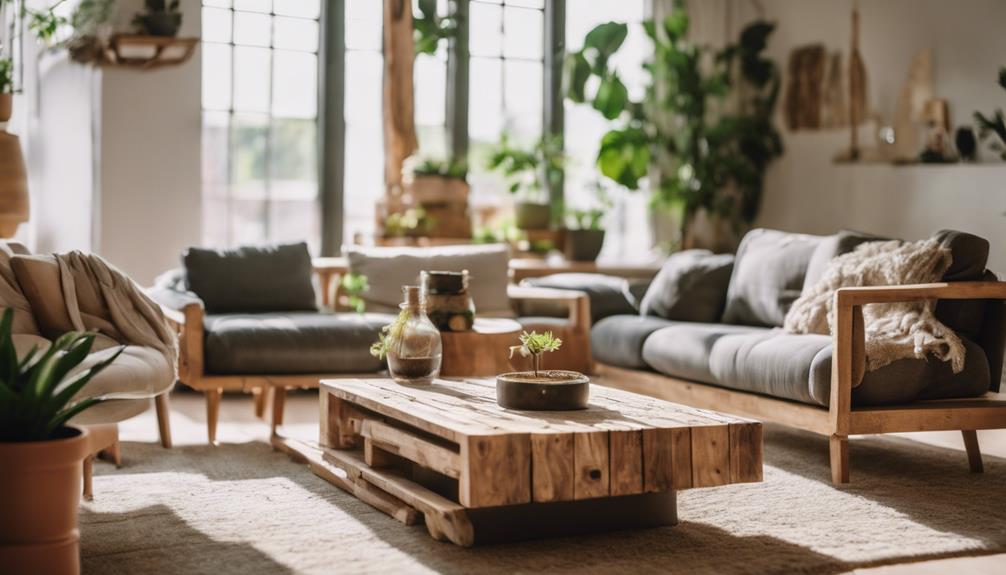
Choosing sustainable decor enhances your living environment by promoting health and well-being through eco-friendly materials and practices. The environmental impact of sustainable decor is significant, as it helps reduce carbon emissions and minimizes harm to the planet.
By opting for eco-friendly options, you contribute to a healthier indoor environment with improved air quality. Traditional home decor often contains harmful chemicals that can negatively affect your health and well-being. In contrast, sustainable decor focuses on using non-toxic materials that enhance air quality and create a safer space for you and your family.
This emphasis on eco-friendly practices not only benefits your immediate surroundings but also supports a larger movement towards sustainable living. Making sustainable decor choices is a proactive step towards improving your quality of life and reducing your carbon footprint. By prioritizing eco-friendly materials, you're investing in a healthier future for yourself and the environment.
Benefits of Eco-Friendly Materials
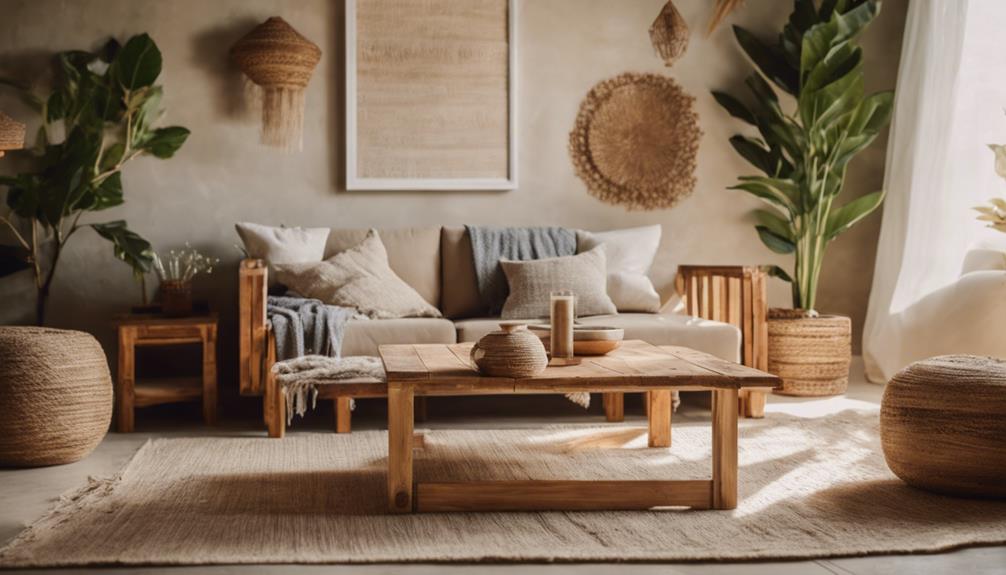
Utilizing eco-friendly materials in sustainable home decor offers numerous advantages that extend beyond just environmental benefits. By choosing materials such as renewable, nontoxic, and recycled components, you can greatly reduce the environmental impact of your decor choices. These eco-friendly materials play an essential role in promoting healthier indoor air quality by avoiding harmful chemicals and volatile organic compounds (VOCs), creating a safer environment for you and your loved ones.
Sustainable materials like FSC-certified wood, organic textiles, and recycled glass not only help conserve natural resources but also encourage responsible sourcing practices. Additionally, opting for these materials supports ethical production practices, ensuring fair wages and safe working conditions for workers throughout the entire supply chain.
Ethical Production Practices

Adopting ethical production practices guarantees a sustainable and responsible approach to creating home decor items. By ensuring fair wages, supporting artisan training, and using recycled materials like metals, brands like ONEOFEACH, Eugenia, and Adele Dejak exemplify the essence of ethical production. These practices not only benefit the environment but also uplift communities and promote social responsibility. Little Pine Tree and Tekura showcase how ethical production can extend to children's toys and wood products, demonstrating a holistic commitment to sustainability. Embracing these principles fosters a conscious consumer culture where the impact of each purchase goes beyond aesthetics, contributing to a better world for all. Below is a table summarizing the ethical production practices of these innovative brands:
| Brand | Ethical Practices | Materials |
|---|---|---|
| ONEOFEACH | Fair wages, artisan training | Ethically sourced |
| Eugenia | Fair wages, sustainably paid farmers | Quality shea butter |
| Adele Dejak | Recycled metals | Sustainable |
| Little Pine Tree | Ethical production practices | Non-toxic |
| Tekura | Upcycled wood offcuts, sustainable production methods | Reforested wood |
Local Sourcing for Home Decor
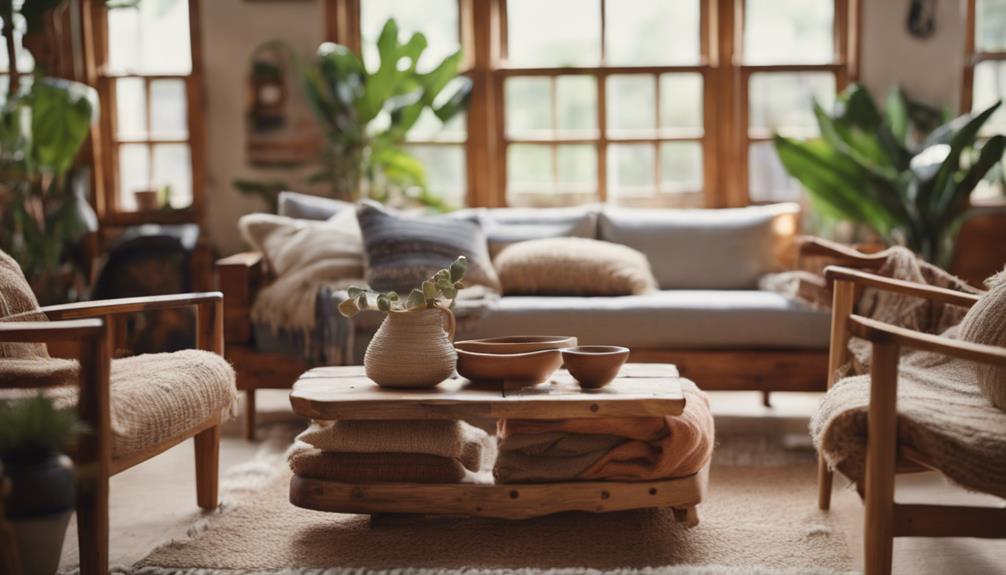
Sourcing materials locally for your home decor supports the community, reduces environmental impact, and guarantees authenticity and quality. When you opt for local sourcing, you contribute to the sustainability of your surroundings by supporting the local economy and promoting sustainable practices. By obtaining materials from nearby suppliers or artisans, you not only reduce transportation emissions but also make sure that your home decor items are ethically produced.
Moreover, choosing locally sourced home decor allows you to connect with the makers, understand the production process, and appreciate the craftsmanship behind each piece. This connection adds a unique touch to your living space, creating a sense of place and individuality. Supporting local artisans and businesses through local sourcing not only benefits you but also helps maintain the cultural and artistic heritage of your community. Embrace local sourcing for your home decor to make a positive impact on both your space and the local economy.
Impact of Non-Toxic Materials

When you choose non-toxic materials for your home decor, you're safeguarding your health by reducing indoor air pollution.
These materials also contribute to a healthier living environment, especially for families with young children or pets.
Opting for non-toxic decor items not only supports your well-being but also helps in minimizing environmental impact.
Health Benefits of Non-Toxic Materials
By prioritizing non-toxic materials in your sustainable home decor choices, you can greatly enhance the health and well-being of your indoor environment. Non-toxic materials play an important role in reducing indoor air pollution by limiting harmful chemicals like VOCs. Opting for these materials promotes better respiratory health, lowering the risk of allergies and respiratory issues.
Sustainable home decor made from non-toxic components creates a healthier indoor environment for you and your family. Items like furniture and textiles, when crafted from non-toxic materials, support overall well-being by minimizing exposure to harmful substances. Choosing non-toxic options aligns with eco-friendly practices, fostering a safer and more sustainable living environment for everyone in your household.
Environmental Impact Reduction
Reducing the environmental impact through the use of non-toxic materials in sustainable home decor is an essential step towards creating a healthier living space. By opting for VOC-free materials, you can decrease indoor air pollution and lower your carbon footprint. These materials help in reducing harmful emissions such as carbon dioxide, thereby contributing to a healthier environment.
Choosing sustainable fabrics, like OEKO-TEX STANDARD 100 certified textiles, guarantees minimal chemical exposure and supports ethical production practices. Additionally, selecting decor items with ECOLOGO® Certification signifies a reduced environmental impact, making them a more eco-conscious choice.
Sustainable forestry certifications, such as SFI and FSC, ensure responsible wood sourcing, protecting forests and biodiversity. Incorporating these non-toxic materials into your decor helps in conserving energy sources and promoting a greener lifestyle.
Safety for All Ages
Using non-toxic materials in sustainable home decor promotes safety for all ages by minimizing exposure to harmful chemicals and fostering a healthier indoor environment. Opting for decor items made from non-toxic materials not only reduces the risk of health issues but also contributes to improved air quality within your living space.
By choosing products with VOC-free components, you can create a safer and healthier environment for you and your family. Embracing non-toxic materials in your home decor supports a sustainable lifestyle while minimizing the environmental impact.
Look for certifications like OEKO-TEX STANDARD 100 to make sure that the decor items you bring into your home adhere to strict safety and health standards, providing peace of mind for you and your loved ones.
Upcycling in Home Decor

When it comes to upcycling in home decor, you'll discover a world of creative possibilities. By repurposing discarded items, you can breathe new life into your living space while reducing waste.
From furniture made of reclaimed wood to unique accessories crafted from recycled materials, the benefits of upcycling in home decor are endless.
Creative Upcycling Ideas
Repurposing old or discarded items creatively into new and functional pieces is a hallmark of upcycling in home decor. By using repurposed materials, upcycling promotes sustainability by giving a new lease of life to items that might've ended up in landfills.
Creative upcycling ideas can add a unique and personalized touch to your living space. For instance, you can turn old pallets into a rustic coffee table or transform glass jars into stylish storage containers. Engaging in upcycling encourages creativity, resourcefulness, and eco-consciousness in decorating your home.
These ideas not only help reduce waste but also showcase your ability to think outside the box and contribute to a more sustainable lifestyle.
Benefits of Upcycling
To truly appreciate the value of upcycling in home decor, consider the positive impact it has on both your living space and the environment. Upcycling involves repurposing old materials into new items, reducing waste and promoting sustainable home decor.
By upcycling, you help decrease the demand for new raw materials, conserving natural resources and lowering energy consumption during production. Upcycled home decor pieces often boast unique designs, adding character to your living space.
Additionally, upcycling contributes to a circular economy by extending product lifespans and minimizing landfill waste. Engaging in upcycling fosters creativity and innovation, encouraging you to think creatively and find new uses for items that would have otherwise been discarded.
Embrace upcycling for a more sustainable and environmentally friendly home decor approach.
Upcycled Decor Examples
Consider incorporating upcycled decor examples into your home to embrace sustainable and eco-friendly design practices. Recycled materials are commonly used in sustainable home decor products, like those offered at 54kibo. Designer Candice Lawrence repurposes wood offcuts to craft smaller upcycled items, while Tekura sources wood offcuts from reforested wood in Ghana for their eco-friendly decor pieces.
Kenyan jewelry designer Adele Dejak incorporates recycled metals in creating unique upcycled jewelry. Upcycled home decor items often feature sustainable practices such as using eco-friendly varnish and employing flat-packed designs. By choosing upcycled decor, you not only add a touch of creativity to your space but also contribute to the conservation of resources and the reduction of waste.
Creating Stylish Eco-Conscious Spaces

Embracing sustainability in your home decor choices can transform your living spaces into stylish and eco-conscious sanctuaries. By opting for eco-friendly materials like reclaimed wood, bamboo, and recycled textiles, you can reduce your environmental impact while adding a touch of natural beauty to your home. Choosing furniture and decor made from these sustainable materials not only enhances the aesthetics of your space but also supports ethical production practices.
In addition to eco-friendly materials, incorporating energy-efficient lighting can further enhance the sustainability of your home decor. Energy-efficient lighting not only saves electricity but also creates a warm and inviting ambiance in your living spaces. By using LED bulbs and fixtures, you can reduce your carbon footprint and contribute to a more eco-friendly lifestyle. Moreover, adding indoor plants and water-saving fixtures can promote a healthier indoor environment while enhancing the overall sustainability of your home decor choices.
Supporting Artisans in Home Decor

Supporting artisans in home decor elevates the authenticity and ethical value of your living space while honoring traditional craftsmanship. By opting for artisan-made sustainable home decor products, you're actively supporting ethically produced items and contributing to the preservation of traditional techniques.
When you purchase these pieces, you not only bring unique designs and cultural influences into your home but also help sustain the livelihoods of skilled craftsmen and women. Additionally, choosing artisan-made home decor adds a personal touch to your space, reflecting your appreciation for handcrafted items and making a positive impact on global artisans and communities.
Through this conscious decision, you promote fair wages, ethical production practices, and the preservation of cultural heritage within the home decor industry. Embrace the beauty of traditional craftsmanship while enhancing the aesthetic appeal of your living environment with artisan-made home decor pieces.
Reducing Environmental Footprint

To minimize your environmental impact through sustainable home decor, prioritize the use of eco-friendly materials and energy-efficient solutions.
Opt for decor items made from recycled materials, such as reclaimed wood, to reduce your carbon footprint and lessen harm to the environment. Choosing non-toxic components and VOC-free materials for your decor not only contributes to a healthier indoor environment but also supports sustainable practices.
Look for certifications like SFI and FSC to make sure that the decor products you purchase are responsibly sourced and align with sustainable forestry practices. Additionally, incorporating energy-efficient appliances and lighting into your home decor can greatly decrease energy consumption, further reducing your environmental impact.
Community Empowerment Through Decor

By incorporating ethically produced decor items, you can actively contribute to empowering communities and supporting sustainable development. Brands like ONEOFEACH provide fair wages and skills training, fostering community development through their ethical production practices.
Local sourcing of materials in sustainable decor not only promotes economic growth but also contributes to long-term sustainability by supporting local businesses. Collaborating with sustainably paid farmers, such as with Eugenia's shea butter, uplifts communities by ensuring a fair income for producers.
Additionally, initiatives like Little Pine Tree, which empower women through craft and skills training, play a significant role in enhancing social equity within communities. When you choose sustainable home decor that values community empowerment, you not only bring unique and ethical pieces into your space but also become a part of a larger movement towards supporting fair labor practices and local development.
Your choices in decor can have a meaningful impact on communities worldwide, making a difference one purchase at a time.
Frequently Asked Questions
How to Decorate Your Home Sustainably?
To decorate your home sustainably, consider the following steps:
Choose furniture made from reclaimed wood or bamboo.
Use energy-efficient LED and CFL bulbs for lighting.
Incorporate houseplants for better air quality.
Consider solar energy to reduce fossil fuel reliance.
Buy locally made decor to support the economy and lessen transportation emissions.
These steps can help lower your environmental impact while creating a stylish and eco-friendly living space.
What Is Sustainable Home Design?
Sustainable home design prioritizes eco-friendly materials and energy-efficient practices to reduce environmental impact. Incorporating elements like energy-efficient lighting, water-saving fixtures, and indoor plants creates a healthier living space.
How to Choose Sustainable Home Decor?
When choosing sustainable home decor, look for certifications like SFI and FSC for forestry, opt for non-toxic, VOC-free materials, and products with reduced carbon footprint certified by ECOLOGO®.
Choose items made from sustainable fabrics like OEKO-TEX STANDARD 100 textiles. Support ethical production by selecting companies that prioritize fair wages and safe working conditions.
What Does "Sustainable" Mean in a House?
When it comes to your house, being sustainable means making choices that are eco-friendly and reduce your impact on the environment.
From using renewable materials to energy-efficient fixtures, every decision you make can contribute to a greener home.
Consider the lifecycle of products, opt for natural and non-toxic materials, and support fair trade practices.
Conclusion
To sum up, sustainable home decor is more than just a trend – it's a conscious choice to protect our planet and support ethical practices.
By opting for eco-friendly materials, ethical production practices, and supporting local artisans, you can create stylish and eco-conscious spaces that reduce your environmental footprint.
So, why not take the step towards a more sustainable future and transform your home into a sanctuary that not only looks good but does good too?
Lighting
How to Choose the Right Transformer Size for LED Strip Lighting
Journey into optimal LED strip lighting performance by selecting the perfect transformer size to match your wattage needs.
When selecting the appropriate size of transformer for LED strip lighting, it is important to first calculate the total wattage of the LED strips that will be connected. It is crucial to match the wattage with the transformer load in order to ensure efficiency and durability. Avoid using transformers that are underpowered, as they may cause flickering and dimming, or overpowered ones that can lead to overheating and premature failure. Proper matching of wattage guarantees optimal performance and longevity. Additionally, it is essential to consider the voltage requirements of the LED strips and choose a transformer that aligns with these specifications for optimal functioning. Ensuring that the transformer size matches the LED strip wattage is key. Explore more insights for a well-functioning lighting setup.
Key Takeaways
- Calculate total LED strip wattage accurately for transformer selection.
- Ensure voltage alignment between LED strip requirements and transformer output.
- Match transformer wattage slightly higher than total LED strip wattage.
- Avoid underpowered transformers to prevent flickering or dimming issues.
- Prevent overpowered transformers to avoid overheating and premature failure.
Calculate Total LED Strip Wattage
To calculate the total LED strip wattage accurately, multiply the wattage per foot by the strip's length and factor in the power consumption of each LED. This calculation takes into account the total wattage of the LED strip by considering the number of LEDs present and their individual power consumption.
By understanding the power requirement of each LED, one can determine the overall power needed for the entire strip. It's crucial to calculate this total LED strip wattage to guarantee that the transformer size selected can handle the combined wattage of all LEDs effectively.
This meticulous calculation aids in choosing an appropriate transformer size that meets the power demands of the LED strip, thereby ensuring satisfactory performance. By accurately evaluating the total LED strip wattage, one can make an informed decision regarding the transformer size needed for the lighting setup.
Determine Voltage Requirements

Determining the voltage requirements for LED strip lighting is important for guaranteeing peak performance and selecting the appropriate transformer size. LED strip lighting commonly operates at either 12V or 24V DC, with different strips having specific voltage needs for best operation. It's essential to understand these voltage specifications to make sure that the transformer matches the requirements of the LED strip.
Selecting the correct transformer voltage is crucial for the safe and efficient operation of the lighting system. Failure to align the transformer's voltage with the LED strip's requirements can lead to issues such as flickering lights, dimming problems, or even damage to the LED strip itself. Therefore, before choosing a transformer size for LED strip lighting, evaluating the voltage requirements of the LED strips being used is a fundamental step to ensure proper functioning and longevity of the system.
Match Wattage With Transformer Load

When matching LED strip wattage with the transformer load, it's essential to guarantee compatibility and proper functioning of the lighting system. To achieve this, one needs to calculate the total wattage of all LED strips that will be connected to the transformer. It's important to avoid oversizing the transformer, as this can lead to unnecessary costs and inefficiency in the system. Conversely, undersizing the transformer can result in power supply failure and potential damage to the LED strips due to insufficient power delivery.
For best performance and longevity of the LED strip lighting system, it's recommended to select a transformer with a wattage slightly higher than the total wattage of the LED strips. This slight increase in transformer wattage ensures that the system operates efficiently without being overburdened. By matching the wattage of the LED strips with the transformer load appropriately, you can ensure a well-functioning and durable lighting setup.
Avoid Underpowered Transformers

Underpowering transformers can cause LED strip lights to function inadequately. When a transformer is undersized for the total wattage of the LED strip lighting, it may struggle to provide sufficient power, leading to issues like flickering or dimming of the LEDs.
An underpowered transformer mightn't be able to handle the peak power requirements of the lights, resulting in inconsistent performance. To guarantee peak performance and longevity of the LED strip lights, it's vital to select a transformer that matches the wattage requirements of the lighting system.
Prevent Overpowered Transformers

To prevent potential issues, make sure that the transformer selected for LED strip lighting has a wattage slightly higher than the total LED strip wattage. Overloading a transformer can lead to overheating and premature failure of the LED strip lighting system.
It's important to calculate the minimum rated power supply accurately using the formula: (LED strip length x watts per foot) / 0.80 for best performance. By selecting an appropriately sized transformer, you guarantee efficient power delivery and the longevity of the LED strips.
Mismatching transformer wattage with LED strip requirements should be avoided to maintain safe and reliable operation. Ensuring that the transformer's wattage is slightly higher than the total LED strip wattage is vital for preventing overloading, which can compromise the system's efficiency and reliability.
Consider Transformer Longevity
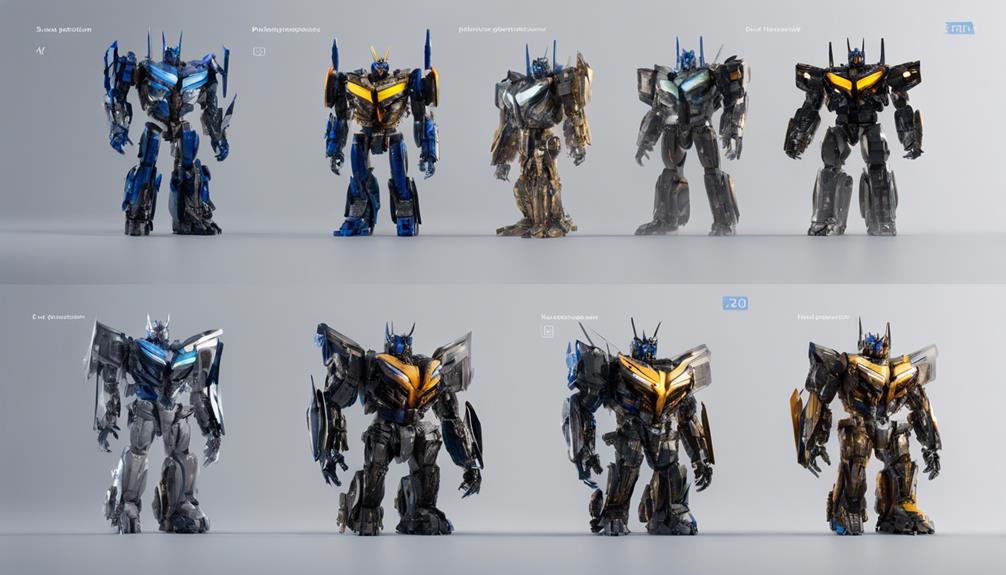
Consideration of transformer longevity is vital in ensuring the top performance and durability of LED strip lighting systems. LED transformers typically have a lifespan of 50,000 hours or more, but certain factors can influence their longevity.
Choosing a transformer with higher wattage than required can extend its lifespan, as it operates more efficiently when not near its maximum capacity. Lower power consumption by LED strips also contributes to prolonging the transformer's life.
Proper ventilation and temperature control are essential in maximizing transformer durability, as excessive heat can shorten its lifespan. Opting for quality transformers from reputable brands is another key factor in ensuring reliability and longevity.
Optimize LED Strip Performance

To enhance the performance of LED strip lighting, users can optimize the transformer size based on the strip length and wattage requirements to guarantee efficient operation. When considering LED power supplies for a strip, it's important to calculate the power consumption by multiplying the wattage of each LED by the LED quantity for the specified strip length.
Voltage drop can occur in longer runs, causing power loss and reducing the real power output as the strip length increases. Some manufacturers adjust the strip output wattage using different resistors to account for these factors. For instance, SMD3528 LEDs have been replaced by SMD2835 LEDs with a lower 0.1W power consumption, affecting the overall wattage rating of the LED strip.
Selecting the appropriate transformer for LED strips based on the strip length and wattage rating is essential to optimize the performance and maintain efficient operation.
Ensure Proper Voltage Compatibility

Ensuring proper voltage compatibility between the LED strip and transformer is essential for safe and efficient operation. LED strips typically require either 12V or 24V power input, which is achieved by stepping down mains voltage using a transformer. Matching the output voltage of the transformer to the voltage requirement of the LED strip is vital to prevent damage to both components. A voltage mismatch can lead to malfunction or even permanent damage in the LED lighting system. By selecting a transformer with the correct output voltage, you can guarantee the longevity and best performance of your LED strip lights. Refer to the table below for a clearer understanding of the importance of proper voltage compatibility in LED strip lighting systems.
| Importance of Proper Voltage Compatibility |
|---|
| Prevents damage to LED strips and transformer |
| Ensures safe and efficient operation |
| Avoids malfunction or permanent damage in the system |
Frequently Asked Questions
How Do I Know What Size LED Transformer I Need?
When determining the appropriate size of an LED transformer, individuals need to calculate the total wattage of their LED strip lights.
It's important to choose a transformer with a wattage that exceeds the total LED strip wattage to prevent overloading.
Considering voltage drop over distance and future expansion plans is essential.
Compatibility between the LED strip voltage and the transformer's output voltage must also be confirmed for proper function.
What Size Light Transformer Do I Need?
When determining the size of a light transformer needed for LED strip lighting, calculating the total wattage and factoring in voltage drop are vital. Selecting a transformer that can handle the peak current draw of the system is necessary.
Choosing an appropriate wire gauge and transformer capacity based on the total load is also significant. Opt for a transformer size with a capacity higher than the actual power consumption to avoid potential issues.
How Many Lights Can a 200 Watt Transformer Handle?
A 200-watt transformer can typically handle around 16.7 amps for LED strip lighting.
The number of lights it can power depends on the wattage of each LED and the total power consumption.
For instance, with each LED consuming 4 watts, a 200-watt transformer can support about 50 LEDs.
It's important to take into account the transformer's power rating to make sure it effectively manages the LED strip lighting system's load.
How Many LED Lights Can You Put on a 300 Watt Transformer?
A 300 watt transformer can typically handle around 750 LEDs on an LED strip. To determine the number of lights a transformer can support, one must consider the wattage of each LED and the total wattage of the LED strip.
It's important to calculate the total wattage of the LEDs to make sure it doesn't exceed the transformer's wattage rating. Matching the transformer's capacity with the LED lights' power requirements is essential for best performance.
Conclusion
In summary, selecting the right transformer size for LED strip lighting is essential for peak performance and longevity.
One interesting statistic to note is that using an overpowered transformer can decrease the lifespan of your LED strips by up to 50%.
By carefully calculating the total LED strip wattage, matching it with the transformer load, and considering voltage compatibility, you can guarantee your LED strip lighting operates efficiently and effectively.
Make informed choices to maximize the potential of your lighting setup.
Lighting
How to Choose the Right Cable Size for LED Lighting
Achieve optimal performance and safety with the right cable size for LED lighting by considering key factors – find out more!
When selecting the appropriate cable size for LED lighting, take into account total wattage, voltage drop, peak current draw, wire gauge, and transformer capacity for optimal performance and safety. Calculate total wattage and divide by 12 to determine the necessary amperage, which is crucial in choosing the right wire gauge. Matching the amperage rating to the wire size helps prevent overheating and voltage drop, ensuring the integrity and safety of the system. It is essential to use insulation that can handle voltage and current, with proper color-coding for easy identification. Test the wire connections with a multimeter to confirm efficient power transfer and prevent any potential hazards. These steps are essential for maintaining an effective and secure LED lighting system.
Key Takeaways
- Consider total wattage of LED lights and voltage drop over cable length.
- Calculate total amperage needed by dividing total wattage by 12.
- Match amperage rating with appropriate wire gauge to prevent issues.
- Use proper insulation and protection for safety and performance.
- Test wire connections with a multimeter for efficiency and safety.
Cable Sizing Basics
When sizing cables for LED lighting, consider the total wattage of the LED lights to determine the appropriate cable size. LED lights require a specific amount of power to function correctly, and this total wattage will guide the selection of the wiring to ensure peak performance.
It's essential to factor in the voltage drop over the cable's length when choosing the cable size for LED lighting. Voltage drop can affect the efficiency of the LED setup, so selecting the right cable size helps minimize this issue.
Additionally, make sure that the cable can handle the peak current draw of the LED lights to prevent overheating or damage. Using the correct wire gauge and transformer capacity is vital to support the total load of the LED lighting system.
Thicker cables are recommended for longer cable runs to reduce voltage drop and maintain the proper functioning of the LED lights. By considering these factors, one can establish a reliable and safe LED lighting setup.
Calculating Amperage for LED Lights

To accurately determine the amperage required for LED lights, calculate the total wattage and divide it by 12. Understanding the total amperage needed for your LED lighting system is important for selecting the appropriate wire gauge. By dividing the total wattage of the LED lights by 12, you can find the total current, or amperage, the system will draw. This amperage calculation is essential for ensuring that the wire size chosen can safely handle the current flow without overheating or causing a voltage drop.
Proper amperage calculation plays a significant role in the efficient and safe operation of LED lighting systems. It helps prevent issues related to resistance, power loss, and potential hazards. By accurately determining the amperage requirements, you can select the right cable size and wire gauge to support the efficient functioning of your LED lights. Paying attention to these details during the planning stage can lead to a more reliable and long-lasting lighting setup.
Matching Amperage to Wire Size

Matching the amperage rating of the LED lighting system with the appropriate wire size is essential for ensuring safe and efficient operation. When the wire size isn't compatible with the amperage rating, issues such as overheating, voltage drop, and electrical hazards can arise.
It's vital to calculate the total amperage draw of the LED lights to determine the required wire size that can handle the maximum current flow without causing problems. Selecting a wire gauge that aligns with the amperage rating of the LED lighting system is key to preventing potential hazards and ensuring reliable functionality.
Properly matching the amperage to the wire size not only maintains the integrity of the LED lighting setup but also guarantees excellent performance and safety. By choosing the right wire size, you can create a secure electrical connection that supports the efficient operation of your LED lighting system.
Importance of Insulation and Protection

What role does proper insulation play in safeguarding LED lighting systems from potential hazards and damage?
Insulation is vital for protecting wires in LED setups, preventing electrical hazards, and ensuring the longevity of the system. The thickness of the insulation should be adequate to withstand the voltage and current flowing through the cable. Quality insulation materials are indispensable for the safety and efficiency of LED applications. Additionally, insulation color coding assists in identifying wires and their functions within the setup.
To enhance durability and reliability, it's important to provide adequate protection such as conduits or cable trays. These protective measures can safeguard the cable from external factors that could lead to damage or malfunction. By prioritizing insulation and protection in LED lighting systems, users can mitigate risks, extend the lifespan of their equipment, and maintain a safe operating environment.
Testing Wire Connections for Efficiency

Effectively testing wire connections using a multimeter is vital for ensuring the proper functioning and safety of LED lighting systems. By checking for voltage drop, continuity, overheating, and resistance in wire connections, one can verify efficient power transfer and prevent electrical hazards.
It's essential to confirm that wire connections are secure and properly insulated to maintain a safe operating environment. Before powering up the LED lighting system, conducting a thorough inspection of the wire connections is necessary to identify any potential issues that could affect performance or safety.
Frequently Asked Questions
What Size Wire Do I Need for LED Lights?
When determining the wire size for LED lights, consider the total wattage to calculate the current flow. Thicker wires are recommended for longer lengths to minimize voltage drop.
By consulting a wire gauge chart based on the current flow, one can select the appropriate wire size for efficient and safe operation of the LED lighting system.
This guarantees top-notch performance and longevity of the lights.
What Cable Should I Use for LED Lights?
When deciding on the cable for LED lights, opting for 18 gauge solid core wire is ideal for its simplicity and effectiveness. This choice minimizes voltage drop, ensuring peak performance and safety. Manufacturers' recommendations should be checked to guarantee compatibility and efficiency with LED setups.
Solid core wire is favored over stranded wire due to its reliability. By selecting the right wire gauge, users can prevent overheating and maintain a secure lighting environment.
What Gauge Wire Should I Use for a LED Light Bar?
For a LED light bar, it's best to use 18 gauge solid core wire. Thicker wire like 18 gauge minimizes voltage drop and efficiently handles current flow.
Solid core wire is favored over stranded wire due to its simplicity and durability. Selecting the right wire gauge guarantees proper current management and prevents overheating in LED setups.
Opting for the correct wire gauge, such as 18 gauge solid core wire, is essential for safety and maximizing LED light bar longevity.
Can I Use 14 Gauge Wire for LED Lights?
Using 14-gauge wire for LED lights is suitable for most setups with low power needs. While it handles minimal current draw well, longer wire runs may require thicker gauges to prevent voltage drop.
Factors like total wattage, wire length, and voltage drop affect the wire gauge choice for LED lights. In general, 14-gauge wire is sufficient for shorter LED setups but may need adjustments for longer distances or higher power demands.
Conclusion
Just like a well-chosen cable supports and powers LED lighting, making the right decisions in life can illuminate our path and guide us towards success. Remember, the right cable size guarantees efficiency and safety, just as making informed choices leads to a brighter future.
So, whether it's selecting the right wire gauge or making important life choices, always remember that the right fit is key to achieving your goals. Choose wisely and shine bright!
Home Decor
Does Costco Own Kirkland Home Decor
Only the curious will discover the truth behind whether Costco owns Kirkland Home Decor – unravel the mystery within!

Costco does not own Kirkland Home Decor. Kirkland’s Home Decor is an independent retail brand that specializes in unique decor items for interior design enthusiasts. They operate separately, offering a wide range of options to enhance living spaces. Established in 1966 by Carl and Robert Kirkland, Kirkland’s has grown from a gift shop to a decor store with 434 locations across 37 states. With trendy and affordable items, Kirkland’s appeals to a broad customer base looking for stylish decor. Recognizing this distinction can help you explore more about Kirkland’s unique products and growth strategies.
Key Takeaways
- Costco does not own Kirkland's Home Decor.
- Kirkland's is an independent home decor retailer.
- Kirkland's was founded by the Kirkland brothers in 1966.
- Kirkland's specializes in unique and trendy decor items.
- Kirkland's operates separately from Costco's Kirkland Signature brand.
Kirkland's Home Decor Ownership

Kirkland's Home Decor stands as an independent retail chain specializing in stylish and unique home decor items, separate from Costco's ownership. Kirkland's offers a diverse range of products tailored for interior design and decor enthusiasts. Known for its distinctive and fashionable home decor items, Kirkland's operates autonomously from Costco, maintaining its own identity in the market.
When you step into a Kirkland's store, you'll encounter a treasure trove of home decor possibilities. From elegant wall art to cozy throw pillows, Kirkland's provides a plethora of options to elevate your living space. Whether you're looking for a statement piece or small accents to enhance a room, Kirkland's offers something for every taste and style preference.
Embrace the opportunity to explore Kirkland's Home Decor, where creativity knows no bounds. Immerse yourself in a world of design inspiration and transform your living spaces into personalized havens with Kirkland's unique and chic home decor selections.
History of Kirkland's Home Decor
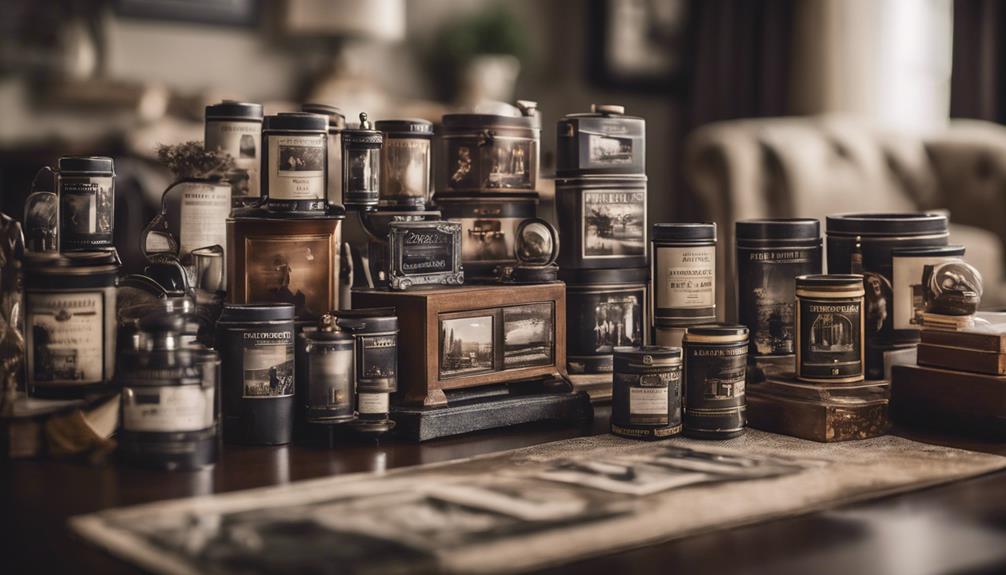
Founded in 1966 by cousins Carl Kirkland and Robert Kirkland in Jackson, Tennessee, Kirkland's Home Decor started as a gift shop before evolving into a specialized store for home accessories. Over the years, the company has expanded its presence to operate 434 stores across 37 states, offering customers a diverse selection of interior design products.
Despite its name similarities, Kirkland's Home Decor is an independent entity in the home decor retail sector and isn't owned by Costco. Known for its distinctive and trendy home decor items, Kirkland's caters to individuals seeking affordable yet stylish design options for their living spaces.
The brand has carved a niche for itself in the market by providing unique and quality products that appeal to a broad customer base looking to enhance their homes with a touch of elegance and creativity.
Comparison: Kirkland's Vs. Costco
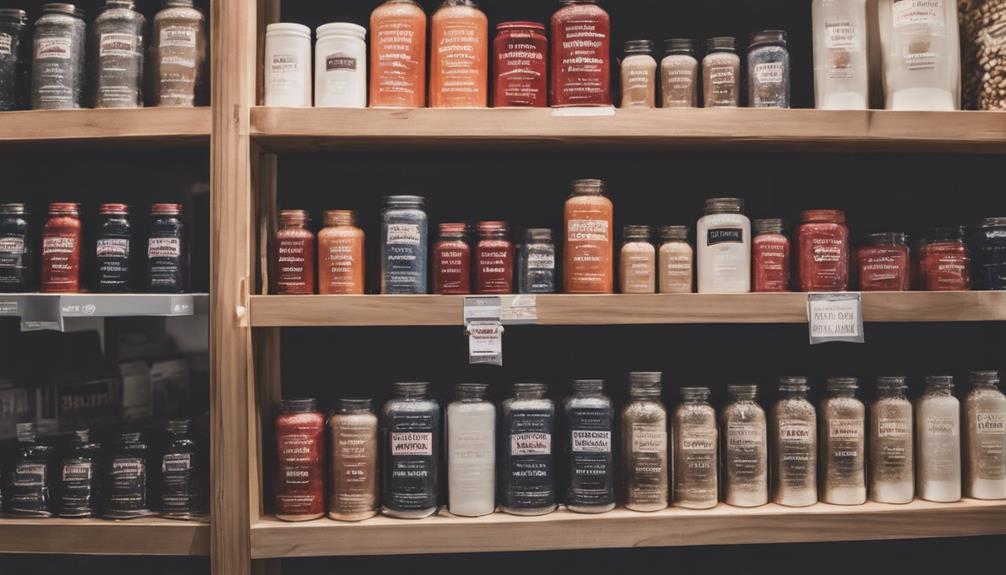
When comparing Kirkland's and Costco, you'll notice a significant difference in price points. Kirkland's tends to offer more affordable home decor items compared to Costco.
Additionally, Kirkland's provides a wider variety of stylish home decor products, catering to different tastes and preferences.
Price Difference Analysis
Comparing the pricing of home decor items between Kirkland's and Costco reveals distinct strategies tailored to their respective retail focuses. While Kirkland's specializes in offering a unique selection of stylish home decor items, Costco, the membership-based warehouse chain that sells home decor under the Kirkland Signature brand, focuses on providing bulk discounts and competitive pricing across various product categories. Here is a comparison table showcasing the differences in pricing strategies between Kirkland's and Costco:
| Pricing Comparison | Kirkland's | Costco |
|---|---|---|
| Pricing Strategy | Individualized based on item type | Bulk discounts and competitive pricing |
| Product Range | Stylish home decor items | Kirkland Signature products in bulk |
| Target Market | Interior design enthusiasts | Broad consumer base with diverse needs |
| Special Offers | Seasonal discounts and promotions | Exclusive member deals and discounts |
| Membership Requirement | None | Costco membership required |
Both retailers aim to provide value to customers through their distinct approaches to pricing and product offerings.
Product Selection Variety
Moving from analyzing the pricing strategies of Kirkland's and Costco, let's now focus on their product selection variety to understand how these retailers differ in catering to customer needs.
Kirkland's Home Decor Stores specialize in home decor and interior design items, offering a curated selection tailored towards home decor enthusiasts seeking trendy and affordable options. They provide unique and stylish pieces for those looking to enhance their living spaces.
On the other hand, Costco carries a wide range of products, including the Kirkland Signature brand, catering to a diverse range of needs beyond home decor. While Kirkland's focuses on a specific niche, Costco offers a broader selection of merchandise across various categories, making it a one-stop shop for a variety of products.
Branding: Kirkland Signature Vs. Kirkland's
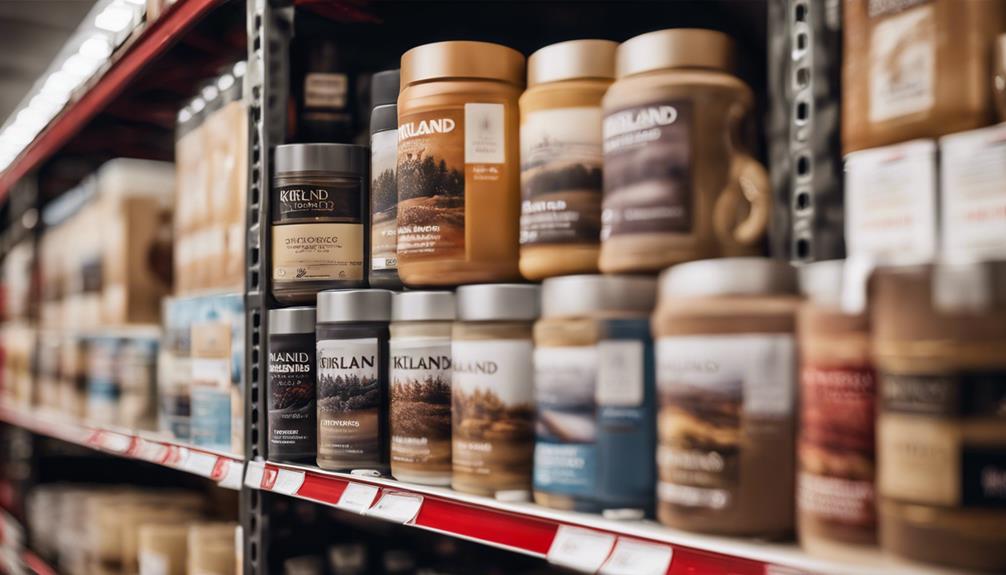
The distinction between Kirkland Signature and Kirkland's Home Decor Stores is essential for understanding the branding strategies of these two separate retail entities.
Kirkland Signature, a brand by Costco since 1992, offers a range of products like clothing, food, and beauty items. In contrast, Kirkland's Home Decor Stores, established in 1966, focuses on home decor, furniture, and gifts.
Despite sharing the name 'Kirkland,' these brands cater to distinct market segments and aren't directly related. Kirkland Signature derives its name from Costco's headquarters in Kirkland, Washington, while Kirkland's Home Decor Stores was founded by Carl Kirkland in Jackson, Tennessee.
It's important to note that although the names may cause confusion, Costco doesn't own Kirkland's Home Decor Stores; they operate independently in the retail industry. Understanding the unique branding approaches of Kirkland Signature and Kirkland's Home Decor Stores sheds light on their individual identities and market positions.
Expansion of Kirkland's Home Decor
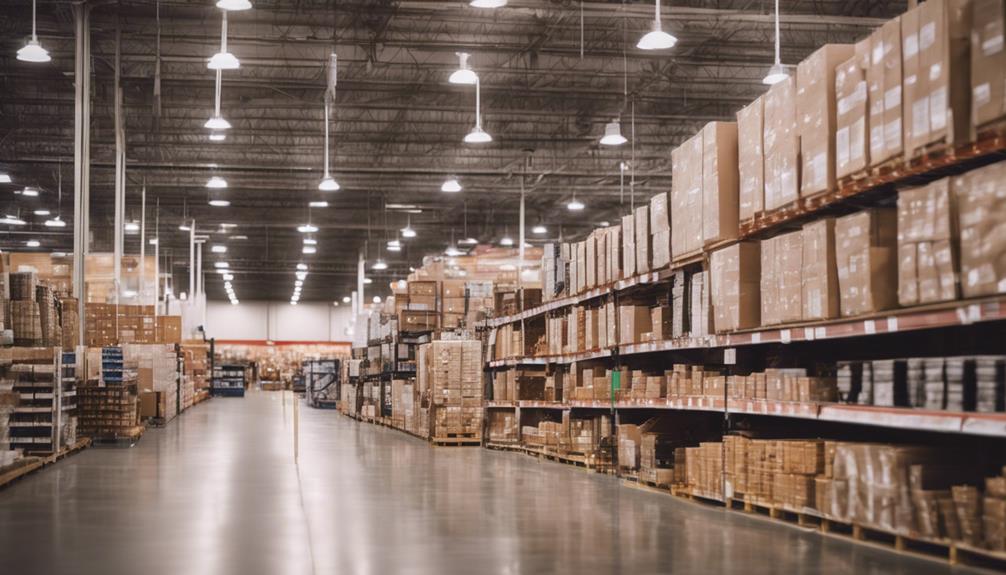
Kirkland's Home Decor has been expanding its product range to offer a wider selection of interior design items. They've been collaborating with various designers to bring unique and stylish pieces to their stores.
Additionally, Kirkland's has been focusing on market expansion efforts to reach more customers seeking trendy and affordable home decor.
Kirkland's Product Range
Boasting an extensive selection of furniture, rugs, and wall art, Kirkland's presents a diverse range of home decor products to cater to various design preferences and needs. You can explore trendy and affordable decor pieces, including seasonal items for holidays and special occasions.
Kirkland's offers both indoor and outdoor decor options, providing everything you need for a complete home makeover. With frequent updates to reflect current design trends, the store maintains a fresh and relevant product range for shoppers. Whether you're looking for stylish accessories or unique decorations, Kirkland's has a wide array of options to enhance your living spaces.
Visit Kirkland's for a one-stop shop to elevate your home decor.
Design Collaborations
Explore the exciting expansion of Kirkland's Home Decor through innovative design collaborations. Kirkland's Home Decor has been proactive in partnering with designers and artists to create unique and exclusive collections that cater to various home decor styles.
These design collaborations bring fresh perspectives and trends to the brand, offering customers a diverse range of options to elevate their living spaces. By working with talented individuals in the industry, Kirkland's Home Decor continues to stay ahead in the market with its private label offerings that stand out for their quality and style.
These collaborations not only enhance the product range but also showcase the brand's commitment to providing customers with exceptional and on-trend home decor items.
Market Expansion Efforts
With a focus on expanding its market presence, Kirkland's Home Decor is strategically positioning itself to reach a broader audience seeking trendy and affordable interior design options. The retail chain that sells home decor is implementing various strategies to enhance its market reach and attract more customers. This includes:
- Introducing new product lines to cater to different design preferences.
- Opening additional store locations in key regions to increase accessibility.
- Enhancing its online presence through e-commerce platforms for convenient shopping experiences.
Future Prospects for Kirkland's Home Decor

Looking ahead, Kirkland's Home Decor is set to continue its growth and success in the competitive home decor retail market, maintaining its focus on providing unique and budget-friendly decor options for customers. As a leading home decor retailer, Kirkland's Home Decor is poised to maintain its reputation for quality and value in the industry. Here is a glimpse of what you can expect from Kirkland's Home Decor in the future:
| Future Prospects for Kirkland's Home Decor | ||
|---|---|---|
| 1. Expansion of Home Decor Products | 2. Introduction of New Accessories | 3. Enhanced Gift Selection |
| Kirkland's Home Decor plans to expand its range of home decor items, catering to various styles and preferences. | The introduction of new accessories will complement the existing decor lines, providing customers with more options to personalize their spaces. | Enhanced gift selection will make it easier for customers to find the perfect gift for any occasion, further solidifying Kirkland's Home Decor as a go-to destination for home and gift shopping. |
Frequently Asked Questions
Is Kirkwood a Costco Brand?
Kirkland isn't a Costco brand.
Kirkland's Home Decor is a separate retail chain specializing in stylish home decor items. It operates independently from Costco, focusing solely on interior design products.
If you're looking for home decor, consider visiting Kirkland's as it offers a wide range of unique items.
Remember, Kirkland Signature is Costco's brand, distinct from Kirkland's Home Decor.
Is Kirkland Brand Owned by Costco?
No, Kirkland's Home Decor isn't owned by Costco. Kirkland's is an independent retail chain specializing in stylish home decor items. They offer a diverse range of products for interior design.
Kirkland's operates separately from Costco and is known for its unique decor options. So, if you're looking for trendy home decor, Kirkland's is the place to go, separate from Costco's ownership.
Does Costco Have a Parent Company?
Costco does have a parent company. The parent company of Costco is called Costco Wholesale Corporation. This corporation oversees the operations and management of Costco warehouses worldwide.
It's responsible for strategic decisions, financial matters, and overall business direction. Costco Wholesale Corporation plays an essential role in guiding the growth and success of the Costco brand, ensuring its continued prominence in the retail industry.
Is Kirkland's Home Associated With Costco?
Kirkland's Home Decor isn't associated with Costco. Kirkland's is a separate retail chain specializing in stylish home decor items, distinct from Costco.
They operate independently, offering a wide range of interior design products. While both companies cater to home goods, they aren't linked in ownership or partnership.
Conclusion
To sum up, while Costco doesn't own Kirkland's Home Decor, the two brands share a similar name. Kirkland's Home Decor has a rich history and unique branding that sets it apart from Costco's Kirkland Signature line.
With a focus on quality and style, Kirkland's Home Decor continues to expand and explore new opportunities in the market. As you navigate the world of home decor, remember the distinct offerings and potential growth of Kirkland's.
-

 Vetted8 months ago
Vetted8 months ago15 Best EMS Foot Massagers for Neuropathy to Soothe Your Feet
-

 Vetted7 months ago
Vetted7 months ago14 Best Personalized Father's Day Gifts for Your Husband – Show Him You Care
-

 Alfresco6 months ago
Alfresco6 months agoAlfresco Stacker Doors: Seamless Indoor-Outdoor Living!
-

 Tableware and Dining Accessories1 week ago
Tableware and Dining Accessories1 week agoWhat Is the Meaning of the Word Tableware
-

 Tableware and Dining Accessories1 week ago
Tableware and Dining Accessories1 week agoWhen Is Tableware on Sale at Hobby Lobby
-

 Tableware and Dining Accessories1 week ago
Tableware and Dining Accessories1 week agoWhich of the Following Is Not Classified as Tableware
-

 Craft and Textiles8 months ago
Craft and Textiles8 months ago15 Best Places to Buy Appliances for Your Home – Top Retailers Reviewed
-

 Tableware and Dining Accessories1 week ago
Tableware and Dining Accessories1 week agoWhat Is the Hindi Meaning of Tableware




























